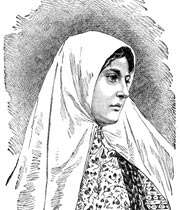Women’s Lives in Ancient Persia
part 2

To what extent Persian family and marriage contracts resembled above examples is hard to say without concrete evidence. But there would have been similarities since Achaemenid extensively utilized Neo-Babylonian and Egyptian codes of conduct and legal systems as part of their imperial policy. One major difference that existed between the Persian women and others in the empire is with respect to the participation in religious cults. Egyptians and Babylonians had many goddesses and temples designated to female deities. Women, including royalty, served and participated actively in running of these temples and ritual ceremonies. Neither the Fortification texts nor the Greek evidence suggests that Achaemenid royal women played any part in religious ceremonies. There is no reference to other women being involved either. We do know that before assuming their throne and going to major wars the kings were ritually blessed at the temple of Anahita””a significant female deity. However, there is no evidence to demonstrate that females including royalty participated at such rituals. Strict purity laws might have restricted women's access to such involvement but in the absence of historical records no conclusion can be made.
The Greek sources and the fortification texts do not shed any light on the subject of veiling and seclusion of Persian women. Veiling has a long history in ancient Mesopotamia and Mediterranean cultures.
In the first known reference to veiling, an Assyrian legal text of the thirteenth century BC, it is restricted to respectable women and prohibited for the prostitutes and lower class women. There is no depiction of women in Persepolis itself, however there are many seals, statues and figurines that indicate there were no restrictions on the depiction of Persian women. In some of these, women are pictured fully clothed with partial veils; in others, they are dressed, even crowned, but with no veil. The aristocratic and royal women very likely used the veil in public as a sign of their higher status. But veiling as an institution to subjugate, control and exclude women from public domain originated after the Islamic conquest.
In summary, the evidence of the Fortification and Treasury texts provide us with a unique insight into the social and economic situation of Persian women, royal and non-royal, as well as female workers. These women owned property and were involved in managing their assets. They also participated in economic activities of the estate and other economic units. They had employment opportunities, earned wages and as a result were able to be economically independent. The patriarchal system prevailed and husbands and other males had far more rights and privileges than their wives or children. Nevertheless, such evidence clearly indicates that women in ancient Iran were not an undifferentiated mass leading a secluded life behind high walls without any function and purpose other than child-rearing””a situation that sadly became their destiny for many centuries after the collapse of the Sassanian Empire.
Source: encyclopedia.thefreedictionary.com
Other Links:
Haft Keshvar (7 Countries)-part 1
History of Ancient Medicine in Mesopotamia & Iran-part 1
Iran, a Brief History (part 1)
A – Z of Iran History (A)
History of Ancient Medicine in Mesopotamia & Iran-part 2